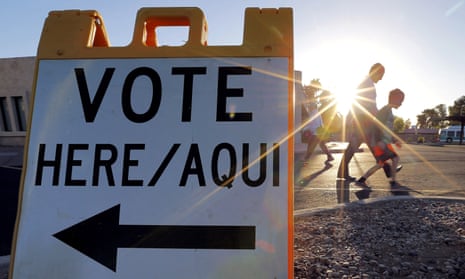In the dying days of the segregation era in 1962, a group of Republican party lawyers, including the future chief justice of the supreme court William Rehnquist, descended on a crowded polling precinct in Phoenix, Arizona, and challenged waiting black and Latino voters to read out sections of the US constitution to prove their bona fides as citizens.
How will the election be decided?
The president is chosen through the electoral college, in which each state is assigned a
The Republicans called this Operation Eagle Eye and claimed, much as Donald Trump’s supporters do now, that the risk of fraudulent voting was so great that only extra vigilance could protect polling stations from mischief. The upshot, though, was simply to deter legitimate voters, many of whom left rather than endure what they saw as bullying and humiliation by confident white men in suits.
When Democratic party poll watchers objected, a scuffle broke out. Eventually, Rehnquist and his colleagues were asked to leave, and the practice of challenging individual voters – a relic of the Jim Crow-era south – was soon outlawed in Arizona and many other states.
With the Trump campaign now predicting the election will be rigged by Hillary Clinton, voting rights activists are once again alarmed by calls from the Republican’s campaign for so-called “volunteer election observers”.
Many voting rights activists worry, however, that just calling for a volunteer army of observers may have a chilling effect on turnout, especially among minority voters. They worry, too, about the toxic political atmosphere that Trump’s rhetoric is creating.
“There is no place for harassment of voters in American democracy,” a group of more than 60 activist groups spearheaded by the Lawyers’ Committee for Civil Rights Under Law wrote in an open letter to all the major political parties. “Unsubstantiated predictions of voter fraud and rigged elections, coupled with the demagogic rhetoric of the last few months towards minority communities, constitute an unacceptable targeting of those members of our society most vulnerable to disenfranchisement.”
Even before Trump launched his presidential campaign, the Republican party had established a track record of controversial challenges to the legitimacy of certain Democratic voters. They have waged a decade-long campaign to introduce voter ID laws and other restrictions that have done little or nothing to prevent fraud . The Brennan Center for Justice has found that voter fraud is less likely than death by lightning strike – between 2000 and 2014 it found just 31 credible incidents of voter impersonation across the entire US.
Courts and activists have warned that the principal effect of these laws has been to suppress the voices of legitimate voters who lean Democratic.
“Unfortunately,” said Kristen Clarke of the Lawyers’ Committee for Civil Rights Under Law, “the problem with voting in the United States is not the voting process itself, but the efforts undertaken at the local and state level in recent years to make voting more difficult, most especially for African American and other minority voters.”
In contrast to Trump’s call for monitors to challenge voters, lawyers and activists have set up elaborate election protection systems across the country so voters suffering harassment can call for help, and groups can dispatch lawyers to defuse problems. They are particularly concerned about Florida and Pennsylvania, where the laws are not as strict as elsewhere.
Trump’s rhetoric – now including the threat that he may refuse to concede if the election goes against him – only compounds a political environment that has already been fraught with challenges following the supreme court’s 2013 decision to overturn parts of the 1965 Voting Rights Act. The ruling not only limited the justice department’s power to stop some voting laws that can have a discriminatory effect; the department is also unable, for the first time in more than 50 years, to send election observers of its own without a court order.
Almost 800 federal election observers were deployed around the country in 2012.
Challenging voters is itself not a new idea. The GOP tried to do it in Ohio in 2004 by sending postcards to Democratic voters at their last known address and then challenging the legitimacy of anyone whose postcard bounced back in the mail – a notorious practice dating back to the civil rights era known as vote caging. The courts stepped in to stop the maneuver in its tracks.
Since then, a conservative poll-watching group called True the Vote has vowed to train 1 million activists to challenge and confront anyone they regard as suspect. The organization said in 2012 it wanted to make the experience of voting for those voters “like driving and seeing the police following you”.
But Trump’s predictions of a rigged election have put him out of step even with many of his fellow Republicans, including his own running mate, Indiana governor Mike Pence, who said on Sunday: “We will absolutely accept the results of the election.”
Even the former senator Kit Bond of Missouri, who was one of the first to advocate voter ID laws, and memorably claimed to have found a springer spaniel who voted Democratic, has said that Trump’s evidence-free pre-emptive allegation of vote-rigging “isn’t going to cut it”.
The split with the party may itself be an obstacle to Trump pursuing any kind of post-election challenge, because the top election officials in several swing states, including Florida, North Carolina, Wisconsin, Georgia and Arizona, are Republicans. If they raise no objection to certifying the results, it is unlikely Trump by himself can do anything to change their minds.
